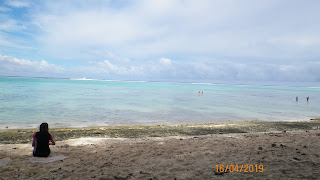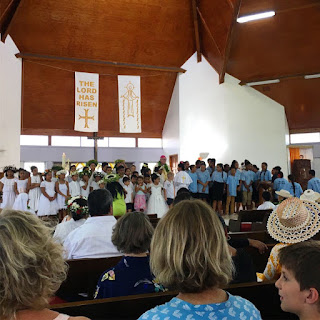Rarotonga – The Cook Islands
In April of 2019, Elaine, Anne, myself and our New Zealand friends Liz, Dennis and Emily O’Callaghan enjoyed a week on the Island of Rarotonga in the Cook Islands. Most people that I have told that we were on Rarotonga had the immediate question of Raro what?
The Cook Islands were first sighted in 1813 and later named after the great explorer James Cook. A self-governing territory of New Zealand, the Cook Islands are made up of 15 inhabited islands in the South Pacific, lying about 2,000 miles northeast of the northern tip of New Zealand. The map-area that the country covers is about the size of India; however, most of that consists of the waters of the Pacific Ocean. The total land-area is about 91 square miles – not very big. The largest of the 15 islands is Rarotonga (24 square miles). Here is a model of the Island:
The nation has a population of about 14,000, 9,000 of whom live on Rarotonga. Since New Zealand has a very close relation with the Cooks, the islanders can live and work in New Zealand without any passports, as they have all the rights of a New Zealand citizen. As employment opportunities are limited in the Cook Islands, over 60,000 of them now live and work in New Zealand. Many years ago, when we lived in NZ, there were a large number of Cook Islanders who attended the same church that we did. We met several of them.
The Cook Islanders are Cook Island Maori, a Polynesian group very closely related to the Maori of New Zealand. The language is similar and can be pretty much understood to the NZ Maori, and vice versa.
As you can see from the model above, this is a volcanic island, as are most of the southern islands. As you move north, the islands are coral atolls. Rarotonga has a coral reef that nearly surrounds the island. Inside the reef is a large lagoon which creates a vast calm area in which one can swim, snorkel or scuba dive.
We spent a few days snorkeling in the water. The darker spots in the water in the photos are volcanic rock, often covered in beautiful coral and abundant multicolored fish. In the one photo, you can see the large area of the reef. It is about half a mile or more to the reef in this area. The reef does come closer to shore in some places. The first photo was taken from our rented home. The reef here was maybe a quarter mile from shore.
Dennis (NZ friend) arranged the accommodations for the six of us. It was a 3 bedroom villa, right on the seashore. It was fully-furnished and had modern facilities.
There are international flights from USA and NZ on Air New Zealand to Rarotonga. To get to the other islands there are interisland flights on smaller planes. As the weather is warm year-round, one gets off and on the planes on the tarmac.
The capitol of the Cook Islands is Avarua, a small town on Rarotonga. Each Saturday, there is a market day. Locals sell their creations at the fair. Baskets, carvings, foods, clothing etc. The specialty is the locally obtained black pearl. The local people also perform native dances, something like the Hawaiian hula, but at a much faster pace.
If you are a fan of franchised fast food outlets (Burger King, etc.) and hotel chains (Sheraton, etc.), the Cook Islands is not a place for you. Hotels are locally owned, as are the restaurants. An attempt to bring in a Sheraton had the following results:
The Sheraton
Rarotonga was a mostly-constructed yet never-opened resort situated in the Cook
Islands. The project could best be described as a PPP or Private Public
Partnership that was backed primarily by local government finances while the
Sheraton agreed to serve as the property managers. This time, there’s no story
of haunting or inauspicious omens. Rumor has it that local mafia members looted
the $36 million development fund. The government ran out of money, and
construction was halted at 80% completion.
We drove by
the structure. Now a big, decaying
concrete structure, covered partially by the encroaching jungle.
Getting around the island is easy, as a paved road encircles the island with the ocean on one side and the jungle and housing on the other. There is a bus that comes along in either direction every hour; or you can use the local popular motor bike (for rent); or rent a car. We used the bus for a few days and then rented a car.
Before the British provided protection of the Cook Islands and Christianized the peoples, there were three main tribes on Rarotonga. Of course, they could not get along with one another and often warred upon one or both of the other tribes. Taking prisoners was the occasion for feasting. The prisoners participated in the feast, as the main course for dinner. The Brits quickly stamped out cannibalism. A new problem arose, what do we do with the deceased? The soil is not deep in most places, with volcanic rock only a few inches underneath the soil. They chose above ground burials in their own front yards or church cemeteries. As property stays within the same family, and is not allowed to be sold to non-islanders, you see many generations of deceased monuments in nearly every yard.
While there, we attempted to learn about their history and culture. We visited a museum, went to a cultural heritage center, enjoyed the dancers at market days and attended religious services at the Catholic Cathedral on Easter Sunday.
The museum is in a large pole-building and has several well-displayed exhibits. Polynesians explored and settled much of the south and eastern Pacific, from Tahiti, to Hawaii, to New Zealand, and the Cook Islands. One of the ways they navigated from island to island was by using stick charts. I have no idea how they used them, but this is what they looked like.
A series of panels in the museum briefly explain the various phases of the islands’ history. I particularly liked this panel, as it shows a couple of their early postage stamps. I have many of their stamps in my stamp albums.
The carvings of their gods (I think that they are of their fertility gods) are very similar to those that we have seen in Hawaii and New Zealand.
The cultural heritage center is located on a mountainside within the jungle. There are no dangerous animals (lions, snakes, crocodiles, etc) which you might meet up with in the jungle or anywhere on the islands. The heritage center has an indoor component which displays various tools, cooking utensils, etc.
The outside portion is a large area of land which includes a temple and various volcanic stones that were used for different purposes. This first picture shows the “guilty rocks”. The story of which is if a person was guilty of violating one of the many taboos, they were executed unless they could carry the rock (the heavier of the two were for the guys and the light for the gals) to the ocean and then back to this place several hundred feet above sea level. Of course, practically no one would be able to carry a two hundred pound rock on this route.
Compass Rock is said to be a navigation device that could be seen from the ocean and was said to be used for navigation to other islands. They must have had really good vision.
A demonstration on how to husk a coconut was given, along with a tasting of the fresh milk and meat of the coconut. If you have ever tried to husk one, you know how difficult it is.
After being guided around the grounds, we were treated to a Polynesian lunch consisting of chicken, plantains, taro and breadfruit all prepared in the traditional way of cooking, an earth oven. Pretty much like a luau would be in Hawaii or a hangi in New Zealand. A fire heats the rocks, then food is laid upon the rocks and then covered with banana leaves.
The chicken was delicious, can’t say the same for the other foods, it was bland and tasteless at least to me. I have had taro before and never had a taste for it. However, we did get to wash it all down with fruit juices and a fresh fruit platter for dessert.
While up in the jungle, we walked to Wigmore Falls, The Cook Islands highest waterfall. It is no Niagara.
One day, while Elaine, Dennis and I went snorkeling, Anne decided to do the cross-island hike. The hike starts at sea level and goes all the way up to Rarotonga’s highest point, the needle. The hike takes about 4 hours. Well, that’s for Anne. For me, I’d still be there.
The two largest western religious denominations are Congregational and Catholic. The largest Congregational Church is quite old (1800s). It sits right next to the former royal palace. The inside is furnished with beautiful wood.
The palace is not fully restored, as funds are lacking. The building is a large structure with a porch (lanai) surrounding it. Some of the rooms inside have some restoration and historical photos.
On Easter Sunday we attended St. Joseph’s Cathedral, one of 3 Catholic Churches on Rarotonga. Instead of bells at consecration, they use a big drum. Songs are pretty much sung acapella. The people dress up in all their finery. For the women, it is a white dress and hat. The tourists are in shorts and shirts.
A warm welcoming people in the south Pacific, good bye for now, I do hope to return.







































